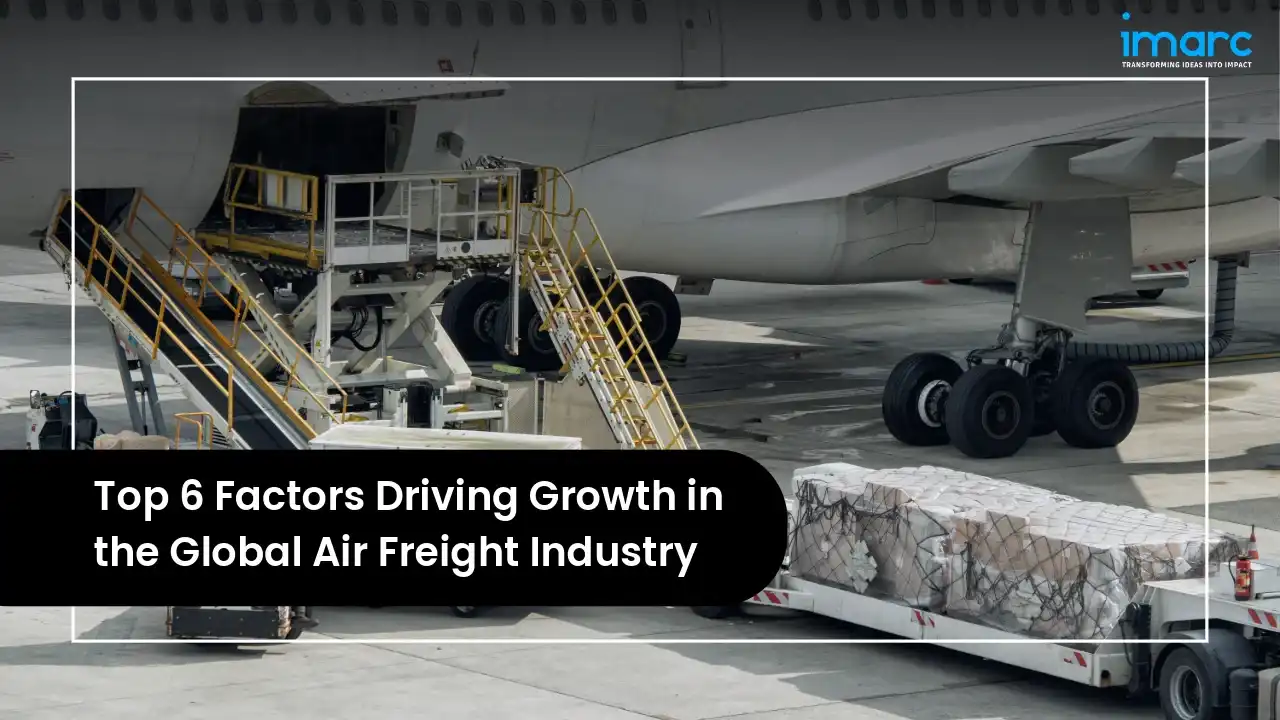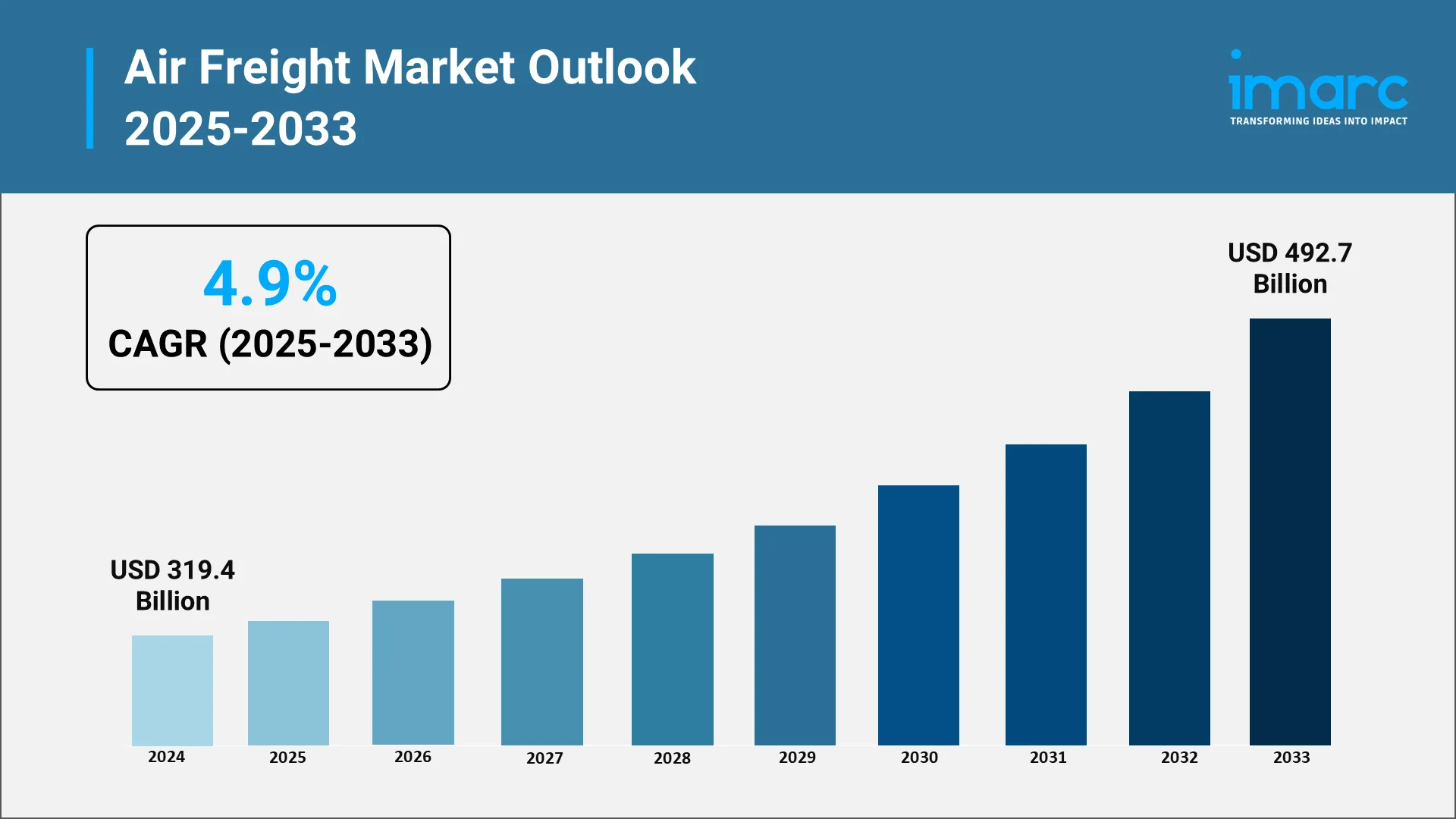Top 6 Factors Driving Growth in the Global Air Freight Industry

Speed, reliability, and supply chain precision have become cornerstones of global commerce. As businesses operate across borders and customers expect shorter delivery times, the need to move products efficiently across continents has become essential. Air freight isn’t just connecting time zones—it’s enabling fast, predictable service that modern logistics depend on.
Driven by the need for speed and reliability, the global air freight market is on an upward trajectory, estimated at USD 319.4 Billion in 2024. With a steady compound growth of 4.9% expected through 2025 to 2033, the sector is forecast to reach USD 492.7 Billion by 2033. As disruptions challenge global supply chains, air freight emerges as a critical enabler of continuity and efficiency.
This article outlines six major forces behind the expansion of international air freight, each contributing to its rising demand and shaping the future of global logistics.

Explore in-depth findings for this market, Request Sample
1. E-commerce Expansion Is Boosting Air Freight Demand
Online shopping continues to grow at double-digit rates worldwide, changing how consumers order and how businesses deliver. With mobile commerce rising and platforms becoming more global, buyers now expect orders within days—even when shipped internationally. This shift has pushed businesses to make air freight central to their fulfillment approach.
For instance, Amazon Air has reshaped India's e-commerce delivery by operating the only dedicated air cargo fleet in the country, currently using two aircraft to transport tens of thousands of packages daily. Since its 2023 launch connecting four major cities, it has expanded to serve 12 cities via air and multimodal air-rail networks, covering over 100 origin-destination pairs. Amazon Air significantly boosts next-day delivery with over 99% on-time performance, overcoming India’s logistical challenges through precise overnight operations, enhancing delivery speed, reliability, and scale ahead of events like Prime Day.
Similarly, in March 2025, CEVA Logistics launched a direct air charter between Wuxi and Chicago to meet growing e-commerce demand, increasing trans-Pacific capacity and shortening delivery times for online retailers. Retailers, DTC brands, and global marketplaces are using air cargo to meet fast delivery expectations and provide consistent service. Fulfillment centers are being located near major airports to support this.
Key Drivers:
- Demand for fast, cross-border delivery
- Growth of mobile-first and international online retail
- Dependence on air cargo for time-sensitive, high-value goods
- Fulfillment networks redesigned around airport access
Retailers are also offering premium delivery options that rely heavily on air transport, as more customers are willing to pay for guaranteed speed. As e-commerce reaches deeper into emerging markets, air freight will continue to play a vital role in expanding reach and meeting service standards.
2. Global Trade Growth Is Lifting International Air Cargo
Cross-border trade continues to fuel economic activity, and its recovery is driving up air freight volumes. As companies expand their sourcing and sales internationally, they’re leaning more on fast, dependable shipping solutions.
In June 2025, global air cargo demand grew modestly by 0.8% year-on-year, driven by a 9.0% surge in Asia-Pacific amid trade tensions and military conflicts impacting other regions. Capacity rose 1.7%, but load factor declined to 45.5%. North America and the Middle East saw notable demand drops (-8.3% and -3.2%, respectively), while Europe had minimal growth (0.8%). Key trade lanes like Europe-Asia (+10.6%) expanded, contrasting with declines on Asia-North America (-4.8%). Lower jet fuel prices and global manufacturing recovery underpin mixed regional performance.
Air freight remains especially important in sectors where delays aren’t an option. Pharmaceuticals, semiconductors, and precision equipment all require fast, secure, and compliant delivery.
Key Drivers:
- Increased global trade activity
- Multi-region supply chain expansion
- Fast delivery needs in regulated or high-value industries
- Use of air cargo for urgent or just-in-time shipments
Multinational manufacturers are using air freight to avoid production delays caused by late components. In complex supply chains, quick shipping ensures smooth operations—especially during peak seasons or amid policy changes.
3. Fleet Expansion and Route Optimization Support Growth
Modernization of cargo fleets is helping the air freight sector keep pace with demand. Airlines are adding wide-body freighters and upgrading aircraft for better efficiency and cargo space. These investments give operators more flexibility along busy routes.
For instance, between March 2024 and March 2025, Amazon Air expanded its U.S. fleet’s cargo capabilities, with a 14% increase in weight capacity and a 12.9% rise in volume. The fleet now includes ten Airbus A330-300 freighters, seven of which joined within the last year. These widebody jets surpass the Boeing 767-300s—Amazon’s second-largest aircraft—in carrying capacity, offering 17% more in tonnage and 6% more in volume. Widebody aircraft now account for more than 75% of Amazon’s domestic available ton-miles, a sharp rise from figures reported three years earlier.
Passenger airlines are also using cargo space on long-haul flights, allowing for extra volume without deploying dedicated freighters. This approach has been key during peak demand or lower passenger traffic.
Key Drivers:
- Larger freighter fleets on major trade lanes
- Increased use of cargo holds in passenger aircraft
- Upgraded airport cargo terminals and logistics hubs
- Smarter routing and AI-based network planning
Airport investments are improving infrastructure, from cold storage and automation to customs pre-clearance. In May 2025, AISATS opened a new logistics park at Bengaluru Airport featuring cold chain capabilities, automated handling, and integrated customs systems. These updates reduce delays and boost capacity, making air freight more dependable.
4. Technology Is Reshaping Air Freight Operations
Digital tools are improving every stage of the air freight process. Carriers and logistics firms are adopting automation, predictive models, and real-time tracking to give customers better visibility and control.
Today’s shippers expect to monitor shipments end-to-end, receive live updates on delays, and track environmental conditions like temperature or vibration. This is especially crucial in sectors like biotech, electronics, and aerospace.
In June 2025, Etihad Cargo rolled out SmartTrack, a sensor-based tracking platform offering real-time shipment data, condition monitoring, and improved oversight. Similarly, cargo.one introduced AI-powered automation and unified workflows to streamline air freight quoting for forwarders in July 2025. It automates shipment data extraction, rate collection, and consolidates all rates—including ad hoc and manual airline rates—into a single platform. A central queue enhances team collaboration, syncing quotes with TMS for faster processing and higher conversion. These innovations boost efficiency by eliminating manual tasks, allowing focus on customer relationships and strategic activities.
Key Drivers:
- Use of IoT, GPS, and smart containers
- AI-powered forecasting and dispatch systems
- Online booking and rate comparison tools
- Blockchain-enabled customs and documentation
By reducing manual steps and improving tracking, digital platforms help teams plan more efficiently and avoid surprises. These improvements also support better communication and service quality, which strengthens customer relationships.
5. Adapting to Shifting Trade Policies and Geopolitics
Changing trade agreements, tariffs, and customs rules are forcing businesses to rethink logistics strategies. In these cases, air freight offers the speed and adaptability needed to respond quickly.
Shifts in trade policies—most notably the United States’ elimination of the de minimis threshold for low-value imports from China in May 2025—have significantly disrupted established air freight patterns. This policy change led to a sharp 27% year-over-year drop in air cargo volumes from China to the U.S., prompting a global reconfiguration of trade routes and supply chain strategies. Furthermore, deals like the RCEP and updates to the USMCA have led companies to revise trade lanes. Many now use air shipping to avoid congested or unstable routes and take advantage of new corridors.
Key Drivers:
- Introduction of new trade agreements
- Shift to air cargo to bypass maritime or rail bottlenecks
- Growth of intra-regional air networks due to nearshoring
- Streamlined customs and faster compliance processes
When trade rules shift, delays can disrupt sourcing, production, and fulfillment. Air freight gives companies flexibility to reroute goods, stay compliant, and keep inventory moving—even with short notice.
6. Sustainability Is Becoming a Core Focus
Environmental concerns are no longer optional—they’re a priority across logistics. As pressure builds from regulators, investors, and customers, air freight providers are adopting cleaner technologies and better emissions tracking.
Carriers are increasing use of Sustainable Aviation Fuel (SAF), upgrading to fuel-efficient aircraft, and switching to electric vehicles for ground handling. In April 2025, IATA launched a global SAF Registry through CADO, enabling airlines to track SAF usage and cut lifecycle emissions. According to the IATA, global production of sustainable aviation fuel (SAF) is expected to double in 2025, reaching approximately 2 million tons. This would account for about 0.7% of the total fuel consumed by airlines worldwide—a notable rise from the 0.3% share in 2024. Despite the growth, SAF still comprises a relatively small fraction of overall aviation fuel use, highlighting the considerable gap that remains to meet net-zero emission targets.
Key Drivers:
- Wider adoption of SAF and cleaner propulsion
- New aircraft with better fuel efficiency
- Solar-powered, energy-efficient terminals
- Built-in emissions tracking in freight platforms
Shippers are also driving change. Many now ask for carbon data in bids and prefer carriers with certified green programs. As carbon regulations expand, sustainable air freight is becoming the new standard—not a premium offering. To meet the growing demand, Neste commenced sustainable aviation fuel (SAF) production at its Rotterdam refinery in April 2025, boosting its global SAF capacity to 1.5 million tons annually. The refinery, capable of producing up to 500,000 tons of SAF yearly, is undergoing expansion to increase renewable fuel output to 2.7 million tons by 2027, making it the largest renewable diesel and SAF facility worldwide. Neste’s total renewable fuels capacity will reach 6.8 million tons, with SAF capacity growing to 2.2 million tons, strengthening its role in reducing aviation emissions.
Why Air Freight Matters Now More Than Ever
Air freight is growing rapidly, powered by rising e-commerce, global trade, smarter logistics, and sustainability goals. These drivers are not just trends—they’re reshaping how goods move internationally.
Air cargo’s speed, precision, and adaptability make it essential in today’s complex supply networks. Companies that invest in the right tools, infrastructure, and partnerships will be better equipped to meet demand, reduce risk, and expand their reach.
Looking ahead, those leading in both delivery speed and emissions performance will define the next chapter of international freight. Now is the time to rethink strategies and act.
How IMARC Can Help Stakeholders Navigate the Global Air Freight Market
To capitalize on growth and navigate the complexities of the global air freight industry, stakeholders require more than just data—they need a strategic partner. IMARC Group offers a suite of services designed to empower airlines, freight forwarders, investors, and technology providers with the actionable intelligence and expert guidance needed to succeed.
Our services are tailored to address the specific challenges and opportunities outlined in this article, from e-commerce integration to sustainability transitions. Here’s how our diverse offerings can help you build a competitive advantage:
- Strategic Consulting & Advisory: Get expert guidance to translate market insights into winning strategy. We help you confidently navigate market entry, risk management, sustainability transitions, and complex trade policies.
- Customized Market Intelligence: Receive research tailored to your exact business needs. We provide deep-dive analysis on niche segments, emerging technologies, or specific geographic markets to inform your critical decisions.
- Competitive Benchmarking & Intelligence: Gain an edge with ongoing analysis of competitor strategies, performance benchmarks, and potential M&A opportunities, allowing you to stay agile in a dynamic market.
- Procurement & Pricing Analysis: Optimize your supply chain with detailed intelligence on rate fluctuations, cost structures, and supplier performance, enabling better negotiations and operational efficiency.
- Investment & Feasibility Studies: De-risk major capital projects with comprehensive feasibility studies. We assess market demand, financial viability, and ROI for investments in fleets, terminals, or new technologies.
By leveraging IMARC Group's integrated services, your organization can move beyond reacting to market changes and begin shaping its future in the global air freight ecosystem.
Our Clients
Contact Us
Have a question or need assistance?
Please complete the form with your inquiry or reach out to us at
Phone Number
+91-120-433-0800+1-201-971-6302
+44-753-714-6104
-(1)_11zon.webp)










